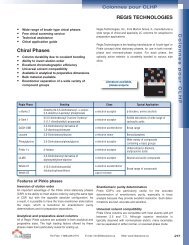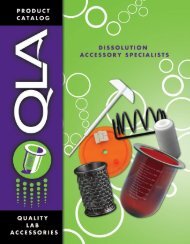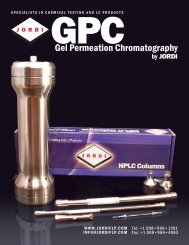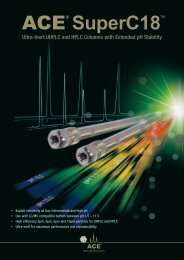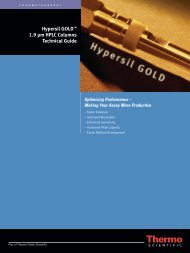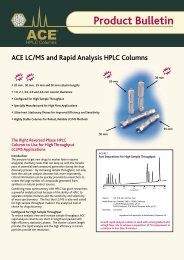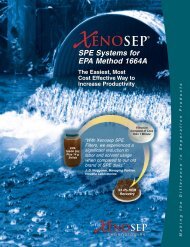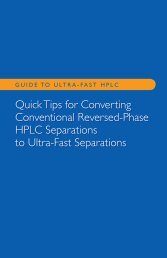Download Entire Catalog - Regis Technologies
Download Entire Catalog - Regis Technologies
Download Entire Catalog - Regis Technologies
Create successful ePaper yourself
Turn your PDF publications into a flip-book with our unique Google optimized e-Paper software.
Gas Chromatography (GC) Derivatization<br />
Sample volatility or thermal stability is<br />
crucial in GC applications. If a sample does<br />
not possess these important characteristics,<br />
GC analysis is highly unproductive.<br />
Derivatization techniques have been<br />
developed to address these issues to insure<br />
successful separations. In GC Derivatization,<br />
replacement of active hydrogen in functional<br />
groups, such as -COOH, -OH, -NH,<br />
and -SH, is the primary area of concern<br />
and is accomplished through either<br />
silylation, acylation or alkylation.<br />
Silylation<br />
Silylation is the most widely used derivatization procedure for sample<br />
analysis by GC. Silylation reagents are popular because they are easy<br />
to use and readily form derivatives. In silylation, an active hydrogen is<br />
replaced by an alkylsilyl group, such as trimethylsilyl (TMS) or t-butyldimethylsilyl<br />
(t-BDMS). Compared to their parent compounds, silyl<br />
derivatives are more volatile, less polar, and more thermally stable.<br />
As a result, GC separation is improved and detection is enhanced.<br />
Silylation reagents are generally moisture sensitive, requiring them to<br />
be sealed under nitrogen to prevent deactivation. The derivatives of<br />
TMS reagents are also moisture sensitive. In response to this difficulty,<br />
t-BDMS reagents were introduced, which enabled the formation of<br />
derivatives 10,000 times more stable to hydrolysis than the TMS<br />
ethers.<br />
Both TMS and t-BDMS<br />
reagents are suitable for a<br />
wide variety of compounds,<br />
offer excellent thermal<br />
stability and can be used<br />
in a variety of GC conditions<br />
and applications.<br />
Analysis by the popular<br />
combination of gas<br />
chromatography and mass<br />
spectrometry (GS/MS)<br />
often requires special<br />
sample derivatization. Particularly effective in these applications<br />
is MTBSTFA.<br />
Acylation<br />
Acylation reagents offer the same types of advantages available<br />
from silylation reagents: creating less polar, more volatile derivatives.<br />
However, in comparison to silylating reagents, the acylating reagents<br />
more readily target highly polar, multi-functional compounds, such<br />
as carbohydrates and amino acids. In addition, acylating reagents<br />
provide the distinct advantage of introducing electroncapturing<br />
groups, thus enhancing detectability during analysis.<br />
Generally, these reagents are available as acid anhydrides, acyl<br />
derivatives, or acyl halides. The acyl halides and acyl derivatives are<br />
highly reactive and are suitable for use where steric hindrance may<br />
be a factor. Acid anhydrides are supplied in a number of fluorinated<br />
configurations, which improve detection. These fluorinated anhydride<br />
derivatives are used primarily for Electron Capture Detection (ECD),<br />
but can also be used for Flame Ionization Detection (FID). Fluorinated<br />
anhydrides are often used in derivatizing samples to confirm drugs of<br />
abuse. Despite the special utility of these reagents, their acidic nature<br />
requires that any excess or byproducts be removed prior to analysis<br />
to prevent deterioration of the column.<br />
For more information visit www.registech.com/gc 43



